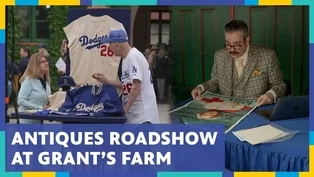Living St. Louis
Cannonball Jail
Clip: Season 2025 Episode 23 | 3m 35sVideo has Closed Captions
A historic jail still draws visitors due to the interesting way its walls were built.
The Macoupin County cannonball jail is a tourist attraction that shows the historic construction method that utilized Civil War era cannonballs to construct the jailhouse.
Problems playing video? | Closed Captioning Feedback
Problems playing video? | Closed Captioning Feedback
Living St. Louis is a local public television program presented by Nine PBS
Support for Living St. Louis is provided by the Betsy & Thomas Patterson Foundation.
Living St. Louis
Cannonball Jail
Clip: Season 2025 Episode 23 | 3m 35sVideo has Closed Captions
The Macoupin County cannonball jail is a tourist attraction that shows the historic construction method that utilized Civil War era cannonballs to construct the jailhouse.
Problems playing video? | Closed Captioning Feedback
How to Watch Living St. Louis
Living St. Louis is available to stream on pbs.org and the free PBS App, available on iPhone, Apple TV, Android TV, Android smartphones, Amazon Fire TV, Amazon Fire Tablet, Roku, Samsung Smart TV, and Vizio.
Providing Support for PBS.org
Learn Moreabout PBS online sponsorship(folksy country music) (metal clinking) - Have you ever wondered what happened with the leftover cannonballs from the Civil War?
In Carlinville, Illinois, they were used to build a jail.
(folksy country music) - Andrea and I really believe that we have an unbelievable amount of sights in town, that's historical and interesting.
- [Host] I sat down with Mary Tinder and Andrea Duncan of the Carlinville Tourism Committee to talk more about the jail's history.
- Its nickname is the Cannonball Jail.
It is a unique jail in and of itself.
And the reason it's called a Cannonball Jail is as they were building the stones that they used, they chiseled out both ends, and then they put a surplus Civil War cannonball in that joint.
And the reason for that was that the prisoners could chisel around the block and then push it out and escape.
- [Host] After the end of the American Civil War in 1865, many of the cannonballs were either melted down or abandoned.
The construction of the jailhouse was commissioned in tandem with the Macoupin County Courthouse project of 1867.
When it came time to hire an architect, Elijah E. Myers was fit for the job.
- E. E. Myers was a young architect out of Springfield, this was his first major commission.
He ended up becoming the only 19th century architect to design three state capitals.
- [Host] Myers would also be the one to suggest incorporating cannonballs into the jailhouse.
(ground rumbling) - It's opened in 1869, and they used it until 1988.
When you think of what a jail is like now, you look at this and you think, "How?
How did they do that?"
It's very historic.
- Well, it's gothic style, I mean- - Yeah.
- It's a beautiful building.
- Well, and it looks like a fortress.
- [Mary] It does.
- You know, it's got the tower and it has the little parapet around the roof.
- Well, it also has a hellhole too.
(Andrea chuckles) So, I mean, there's that.
- [Host] The jail ceased operations in 1988, closing out its 119 year run.
But after a few odd years of disrepair, the restoration project was taken on by Andrea and Mary.
- So we're serving on the Tourism committee together.
It was sort of a natural mix.
So, we said, "We're not doing enough.
What else can we do?"
So we just started meeting on our own and rolling it forward, doing the best that we could without permission.
(chuckles) - But we do make- - We won't do that- - We do make plans and then ask for permission, too.
- Most of the time.
(Andrea and Mary laughing) We really wanted this jail open every day from April to October.
Andrea and I, we sat and wrote and wrote, and helped them make signage, so that it could be self-guided.
So you could walk in here any day you wanted at nine o'clock by yourself, and we trust you to walk around and learn as much as you can.
So, I guess we did all that.
Sometimes, we know that's what made us so tired.
(Andrea and Mary laughing) - [Host] The work that Andrea and Mary have done for the jail is extensive, but from my brief conversation with them, it's clear that they take pride in their work.
- In a small town, you don't always have a tourism office, so there's no central point, but yet we knew how much traffic we were missing, and how many times we saw people wanting in this building, it's not that hard to put it on your agenda every day after a cup of coffee, whose turn is it to open the jail, yours or mine?
(folksy orchestral country music)
Video has Closed Captions
Clip: S2025 Ep23 | 7m 51s | We take a behind-the-scenes look at Antiques Roadshow filming at Grant’s Farm in St. Louis. (7m 51s)
Video has Closed Captions
Clip: S2025 Ep23 | 7m 39s | Bridge Bread Bakery employs unhoused St. Louisans as bakers while providing stable housing. (7m 39s)
I am St. Louis: Wainwright Building
Video has Closed Captions
Clip: S2025 Ep23 | 4m 56s | The Wainwright Building had significant influence on modern architecture. (4m 56s)
Providing Support for PBS.org
Learn Moreabout PBS online sponsorshipSupport for PBS provided by:
Living St. Louis is a local public television program presented by Nine PBS
Support for Living St. Louis is provided by the Betsy & Thomas Patterson Foundation.
















